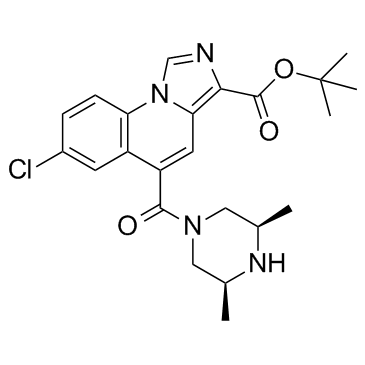| Description |
U-101017 is a partial agonist of benzodiazepine receptor and GABAA receptor, with anxiolytic effects.
|
| Related Catalog |
|
| In Vitro |
PNU-101017 potentiates GABA-stimulated Cl- currents at low concentrations (<1 μM)[1]. U-101017 concentration-dependently inhibits the binding of [3H]FNZ to the membrane preparation of rat cerebral cortex in vitro with Ki of 3.37±0.22 nM[2].
|
| In Vivo |
Pre-ischemic treatment with either PNU-101017 significantly protects the CA1 neuronal population, and PNU-101017 reduces the loss to 50%. Delaying PNU-101017 administration until immediately after reperfusion does not reduce the neuroprotective activity[1]. U-101017 (30 μmol/kg, p.o.) time-dependently blocks [3H]FNZ binding to the mouse cerebral cortex. U-101017 dose-dependently decreases the levels of cGMP with ED50s of 260.0 (163-425) and 0.37 (0.12-1.04) in nonstressed and foot shock-stressed mice, respectively. Flumazenil, an antagonist of GABAA receptors, has no significant effect on cGMP in nonstressed mice, but pretreatment with flumazenil significantly blocks U-101017 (10 μmol/kg, p.o.)-induced reductions in cGMP. In stressed mice, flumazenil is ineffective in altering cerebellar cGMP, but pretreatment with these doses of flumazenil significantly (p < 0.01) blocks U-101017-induced attenuation of stress-induced elevations in cGMP[2].
|
| Animal Admin |
Three groups of gerbils (N=9-11/group) are treated i.p. with either vehicle (0.05 N HCl), PNU-101017 (30 mg/kg) or diazepam (10 mg/kg) 30 min prior to ischemia and again 2 h after reperfusion. Two other groups receive PNU-101017 or diazepam immediately after reperfusion and again 2 h later. The tested doses of PNU-101017 and diazepam are selected from past studies demonstrating their neuroprotective efficacy in the gerbil forebrain ischemia model. The administration of the second dose at 2 h after reperfusion is consistent with previous dosing with other effective compounds tested in the gerbil. The 0.05 N HCl vehicle has been employed for i.p. dosing with other test compounds and is devoid of toxicity or acute distress production.
|
| References |
[1]. Hall ED, et al. Comparative neuroprotective properties of the benzodiazepine receptor full agonist diazepam and the partial agonist PNU-101017 in the gerbil forebrain ischemia model. Brain Res. 1998 Jul 6;798(1-2):325-9. [2]. Sethy VH, et al. The novel anxiolytic U-101017: in vitro and ex vivo binding profile and effect on cerebellar cGMP. Pharmacol Biochem Behav. 1997 Oct;58(2):609-13.
|
